Simulation Study on Topology Characteristics and Cascading Failure of Hefei Subway Network
Abstract
1. Introduction
2. Basic Structure Analysis of the Hefei Subway Network
2.1. Hefei Subway Topology Network Construction
- (1)
- The data used in the topology diagram were sourced from the public scheme of the Hefei subway’s construction planning and actual subway operation data, which are generally consistent with the actual future of the Hefei subway’s construction in terms of the general development direction and construction scale. Although there may be some minor differences in the specific station planning, the impact on the analysis results was small.
- (2)
- The nodes in the subway network are unique, and it was stipulated that an adjacency matrix with a value of 1 indicates the connected edge between station pairs in the line network, and, conversely, if there is no relationship between two nodes, it is indicated by 0.
- (3)
- The difference between the upstream and downstream of a subway traffic line was not considered.
- (4)
- The track train model, frequency, station traffic, facilities, and other factors were not considered.
- (5)
- According to the Hefei subway’s construction plan, the four stations within the interval from Qinglonggang station to Beiyanhu station of Line 4 will be classified within Line 6 after the passage of Line 6, and a topological map will be drawn according to the planning scheme after the passage of Line 6.
2.2. Statistics on the Basic Characteristic Parameters of the Hefei Subway Network
2.2.1. Indicators of the Subway Network’s Characteristic Parameters
- (1)
- Degree-related indicators
- (2)
- Betweenness
- (3)
- Connectivity
- (4)
- Indicators related to the shortest path length
2.2.2. Relevant Parameters of the Hefei Subway Network
2.3. Statistics on the Changes of Indicators of Hefei Subway Network in Different Periods
3. Analysis of the Complexity of the Hefei Subway Network
- (1)
- Analysis of the distribution pattern of the node degree
- (2)
- Analysis of the small-world network characteristics
- (3)
- Analysis of the degree of aggregation of the subway stations
- (4)
- Node degree and betweenness relationship analysis
- (5)
- Analysis of the closeness of the nodes
4. Improved Cascade Failure Model for the Hefei Subway Network
4.1. Node Load Settings
4.1.1. Initial Load
4.1.2. Node Capacity
4.1.3. Ultimate Load
4.2. Load Redistribution Model
- (1)
- When the actual load of the node is between the initial load and the node capacity, the node is defined as a normal state.
- (2)
- When the actual load of the node has not yet reached the maximum limit but has exceeded the node capacity, it is defined that the node is in a state of overload but not failure. At this time, reasonable dredging of the load can speed up the return of the node to a normal state.
- (3)
- When the actual load of the node exceeds the limit capacity, the node is defined as a failure state. At this time, the station will be interrupted, and all its traffic will be propagated along the edge of the network to adjacent nodes.
5. Impact Analysis of Cascading Failures
5.1. Attack Test
5.1.1. Attack Strategy
5.1.2. Node Importance Evaluation System
- (1)
- Evaluation indexes of importance
- (2)
- Calculation of the index weights
- (3)
- Node importance evaluation
5.2. Robustness Analysis
- (1)
- Network efficiency
- (2)
- The proportion of maximal connected subgraphs
5.3. Analysis of the Results
5.3.1. Analysis of the Index Changes
5.3.2. Adjustment Analysis of the Nodal Coefficients
6. Conclusions
- (1)
- The cumulative distribution of the node degrees of the Hefei subway network conforms to a Gaussian distribution, which is quite different from both the scale-free network and the random network and does not have the characteristics of a small-world network. However, as the planning work progresses, the subway network will gradually evolve towards the direction of a small-world network.
- (2)
- The changes in network structure indicators at different periods of the Hefei subway network revealed that the network structure is developing towards complexity, and the aggregation of the nodes and the network connectivity are increasing. In addition, since a triangular structure formed by three nodes penetrating each other in the subway network can realize fast transfer of passengers, if the number of triangular structures is consciously increased in the planning and construction of the subway network, it will be beneficial to the stability of the subway network structure and the improvement of the transportation efficiency.
- (3)
- The Hefei subway network is more resistant to random attacks than deliberate attacks; so, in the actual construction and maintenance, the capacity of the important nodes should be reasonably increased, and the passenger transportation capacity and load regulation capacity of key stations should be improved to prevent and reduce the chance of node failure and the cascade failure phenomenon.
Author Contributions
Funding
Institutional Review Board Statement
Informed Consent Statement
Data Availability Statement
Conflicts of Interest
References
- Bao, D.; Gao, C.; Zhang, Z.L. Analysis of robustness of bus and subway interdependent network based on the complex network theory. J. Southwest China Norm. Univ. Nat. Sci. Ed. 2017, 42, 22–27. [Google Scholar]
- Xing, Y.Y.; Lu, J.; Chen, S.D.; Dissanayake, S. Vulnerability analysis of urban metro transit based on complex network theory: A case study of Shanghai metro. Public Transp. 2017, 9, 501–525. [Google Scholar] [CrossRef]
- Shi, J.G.; Wen, S.P.; Zhao, X.B.; Wu, G. Sustainable development of urban rail transit networks: A vulnerability perspective. Sustainability 2019, 11, 1335. [Google Scholar] [CrossRef]
- Zhang, J.H.; Wang, Z.; Wang, S.; Luan, S.; Shao, W. Vulnerability assessments of urban rail transit networks based on redundant recovery. Sustainability 2020, 12, 5756. [Google Scholar] [CrossRef]
- Ding, R.; Zhang, T.; Zhou, T.; Zhang, Y.; Li, T.; Wu, J. Topologic characteristics and sustainable growth of worldwide urban rail networks. Int. J. Mod. Phys. B 2021, 35, 2150151. [Google Scholar] [CrossRef]
- Chao-Qun, M.A.; Shuang, Z.H.; Quan, C.H.; Rui, C.A.; Lu, R. Characteristics and vulnerability of rail transit network based on perspective of passenger flow characteristics. J. Traffic Transp. Eng. 2020, 20, 208–216. [Google Scholar]
- Zhu, Y.Y.; Li, X.J.; Li, L.L. Research on vulnerability risk assessment of subway network. J. Harbin Univ. Commer. Nat. Sci. Ed. 2021, 37, 450–455. [Google Scholar]
- Cai, J.M.; Deng, W. Complex characteristics of Changsha metro network and robustness analysis of cascading failures. J. Railw. Sci. Eng. 2019, 16, 1587–1596. [Google Scholar]
- Xiong, Z.H.; Yao, Z.S. Influence scope of cascading failure on rail transit system. J. Transp. Syst. Eng. Inf. Technol. 2020, 20, 12–18. [Google Scholar]
- Fan, Y.; Zhang, F.; Jiang, S.H.; Gao, C.; Du, Z.; Wang, Z.; Li, X. Dynamic robustness analysis for subway network with spatiotemporal characteristic of passenger flow. IEEE Access 2020, 8, 45544–45555. [Google Scholar] [CrossRef]
- Li, S.J.; Shuai, B.; Liu, Y.S. Cascading failure mechanism of urban rail transit network. China Transp. Rev. 2020, 42, 69–74+120. [Google Scholar]
- Wang, Y.Y.; Tian, C.W. Measure vulnerability of metro network under cascading failure. IEEE Access 2020, 9, 683–692. [Google Scholar] [CrossRef]
- Xie, B.K.; Tu, X.Y.; Li, Q. Robustness analysis of urban rail transit network. Sci. Technol. Eng. 2020, 20, 11693–11697. [Google Scholar]
- Yang, J.F.; Zhu, D.P.; Zhao, R.L. Analysis on characteristics of urban rail transit network and robustness of cascading failure. Comput. Eng. Appl. 2022, 58, 250–258. [Google Scholar]
- Sienkiewicz, J.; Hoyst, J.A. Statistical Analysis of 22 Public Transport Networks in Poland. Phys. Rev. E Statal Nonlinear Soft Matter Phys. 2005, 72, 046127. [Google Scholar] [CrossRef]
- Zhang, L.; Lu, J.; Fu, B.B.; Li, S.B.; Li, Y.X.; Long, M. A Quantitatively Controllable Mesoscopic Reliability Model of an Interdependent Public Transit Network Considering Congestion, Time-delay Interaction and Self-organization Effects. Nonlinear Dyn. 2019, 96, 933–958. [Google Scholar] [CrossRef]
- Cao, N.; Cao, H. Exploring the Robustness of Urban Bus Network: A Case from Southern China. Chin. J. Phys. 2020, 65, 389–397. [Google Scholar] [CrossRef]
- Yi, S.; Shao, F.J.; Sun, R.C.; Li, S.J. Space evolution model and empirical analysis of an urban public transport network. Phys. A Stat. Mech. Its Appl. 2012, 391, 3708–3717. [Google Scholar]
- Fei, Y.L.; Jin, Y.Q.; Chang, Z. Equilibrium of Topology and Layout of Urban Multimode Public Transit Network. China J. Highw. Transp. 2021, 34, 127–138. [Google Scholar]
- Mou, N.Y.; Kang, Q.P.; Jia, C.F. Vulnerability assessment of urban express networks under influence of emergencies. China Saf. Sci. J. 2020, 30, 125–132. [Google Scholar]
- Derrible, S.; Kennedy, C. The complexity and robustness of metro networks. Phys. A 2010, 389, 3678–3691. [Google Scholar] [CrossRef]
- Yang, Y.H.; Liu, Y.X.; Zhou, M.X.; Li, F.; Sun, C. Robustness assessment of urban rail transit based on complex network theory: A case study of the Beijing subway. Saf. Sci. 2015, 79, 149–162. [Google Scholar] [CrossRef]
- Wang, S.L.; Lv, W.Z.; Zhang, J.H.; Zhou, D.; Wang, Z. Method for urban subway network controllability analysis. In Proceedings of the 2019 Chinese Control and Decision Conference (CCDC), Nanchang, China, 3–5 June 2019; IEEE: New York, NY, USA, 2019; pp. 1276–1279. [Google Scholar]
- Barabasi, A.L.; Albert, R. Emergence of scaling in random networks. Science 1999, 286, 509–512. [Google Scholar] [CrossRef] [PubMed]
- Watts, D.J.; Strogatz, S.H. Collective dynamics of ‘small-world’ networks. Nature 1998, 393, 440–442. [Google Scholar] [CrossRef] [PubMed]
- Song, L.L.; Deng, Y.L.; Yuan, J.F.; Li, Q.M. Analysis of metro operation disturbances based on complex network theory. J. Southeast Univ. Nat. Sci. Ed. 2017, 47, 1069–1073. [Google Scholar]
- Geng, D.Y.; Guo, L.L.; Li, B. Comparative analysis of Shenzhen and Tokyo metro systems based on complex network theory. J. Highw. Transp. Res. Dev. 2015, 32, 126–132. [Google Scholar]
- Du, F.; Huang, H.W.; Zhang, D.M.; Zhang, F. Analysis of characteristics of complex network and robustness in Shanghai metro network. Eng. J. Wuhan Univ. 2016, 49, 701–707. [Google Scholar]
- Gao, T.Z.; Chen, K.M.; Li, F.L. Topology analysis of urban metro transit network. J. Chang. Univ.Nat. Sci. Ed. 2018, 38, 97–106. [Google Scholar]
- Huang, Y.Y.; Jin, C.; Rong, L.L. Model for Cascading Failures of Logistics Network Considering Transportation Directions. J. Syst. Manag. 2015, 24, 756–761. [Google Scholar]
- Tian, H.; Guo, R.J. Study of Urban Road Network Cascading Failure based on Network Load Capacity Model. J. Dalian Jiaotong Univ. 2019, 40, 15–20. [Google Scholar]
- Motter, A.E.; Lai, Y.C. Cascade-based attacks on complex networks. Phys. Rev. E 2002, 66, 065102. [Google Scholar] [CrossRef] [PubMed]
- Yang, C.R.; Li, Y.F.; Zou, X.; Jiang, P.; Fan, M. A research on evaluating long and steep grade of railway in difficult mountainous areas with improved AHP-Entropy weight method and topsis. Railw. Stand. Des. 2021, 65, 52–58. [Google Scholar]
- Xue, L.; Zhao, S.C. Comprehensive evaluation of urban rail transit operation performance and diagnosis of obstacle factors based on entropy-topsis-obstacle degree. In Proceedings of the 2020 5th International Conference on Information Science, Computer Technology and Transportation (ISCTT), Shenyang, China, 13–15 November 2020; IEEE: Piscataway, NJ, USA, 2020; pp. 575–581. [Google Scholar]
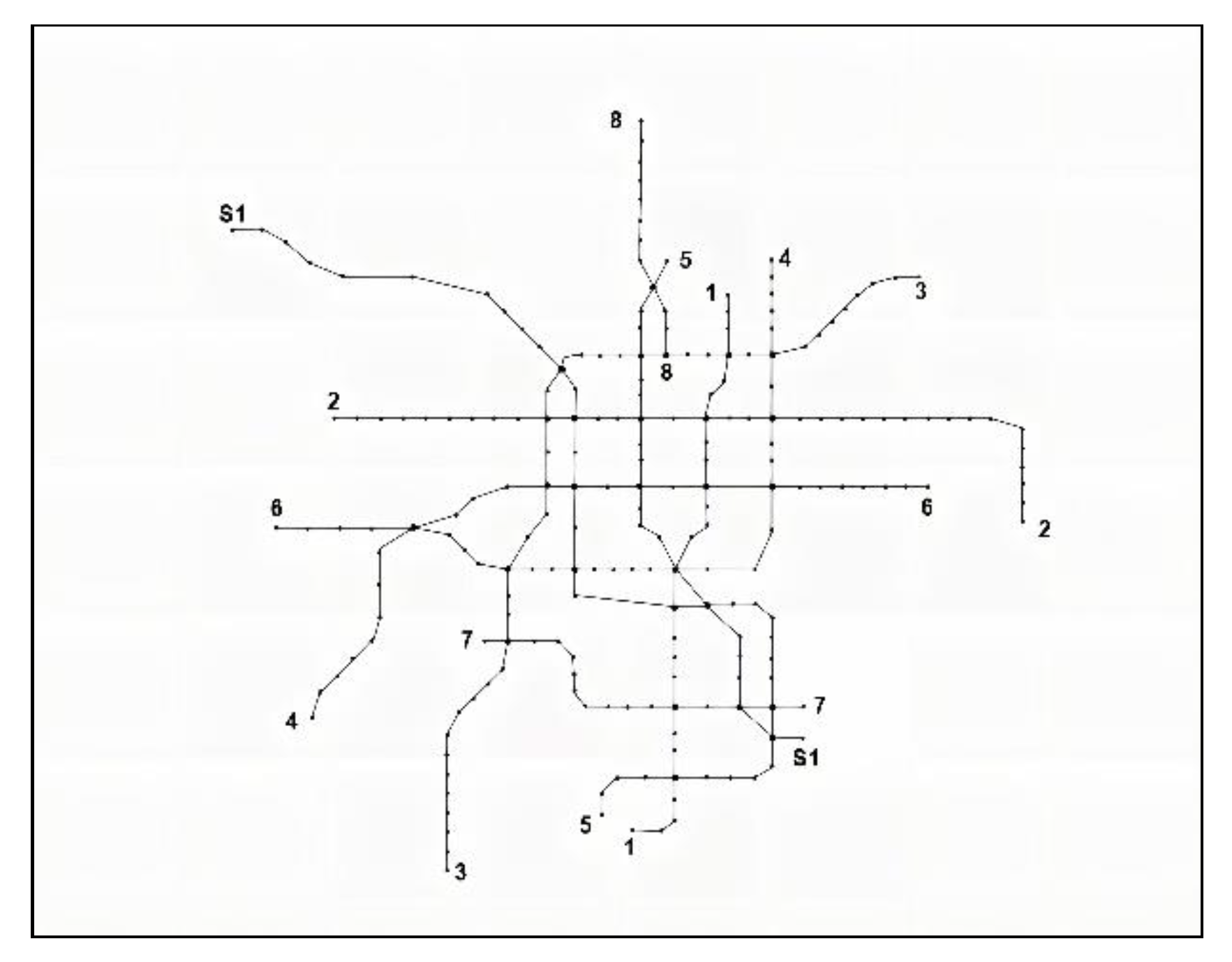
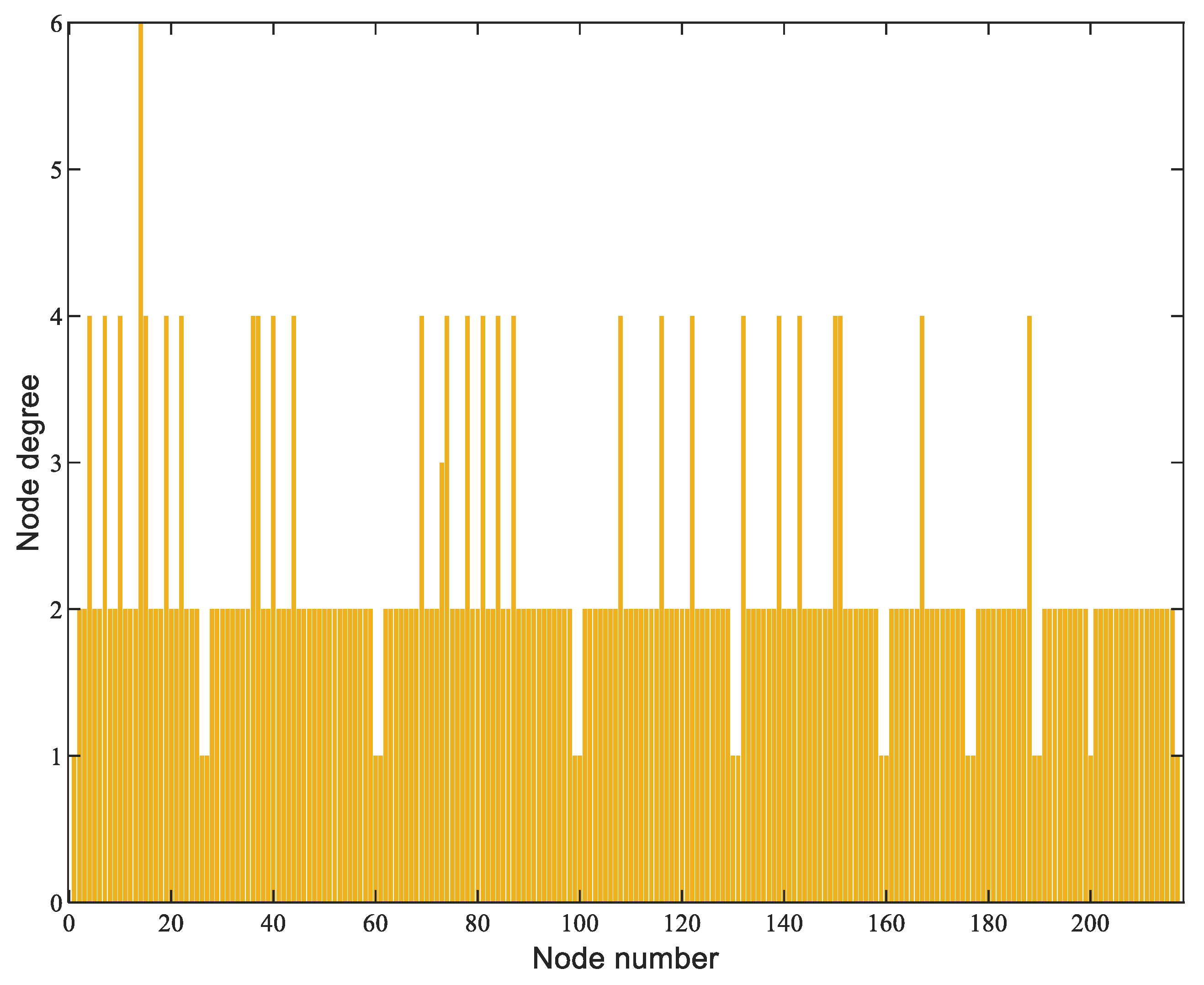
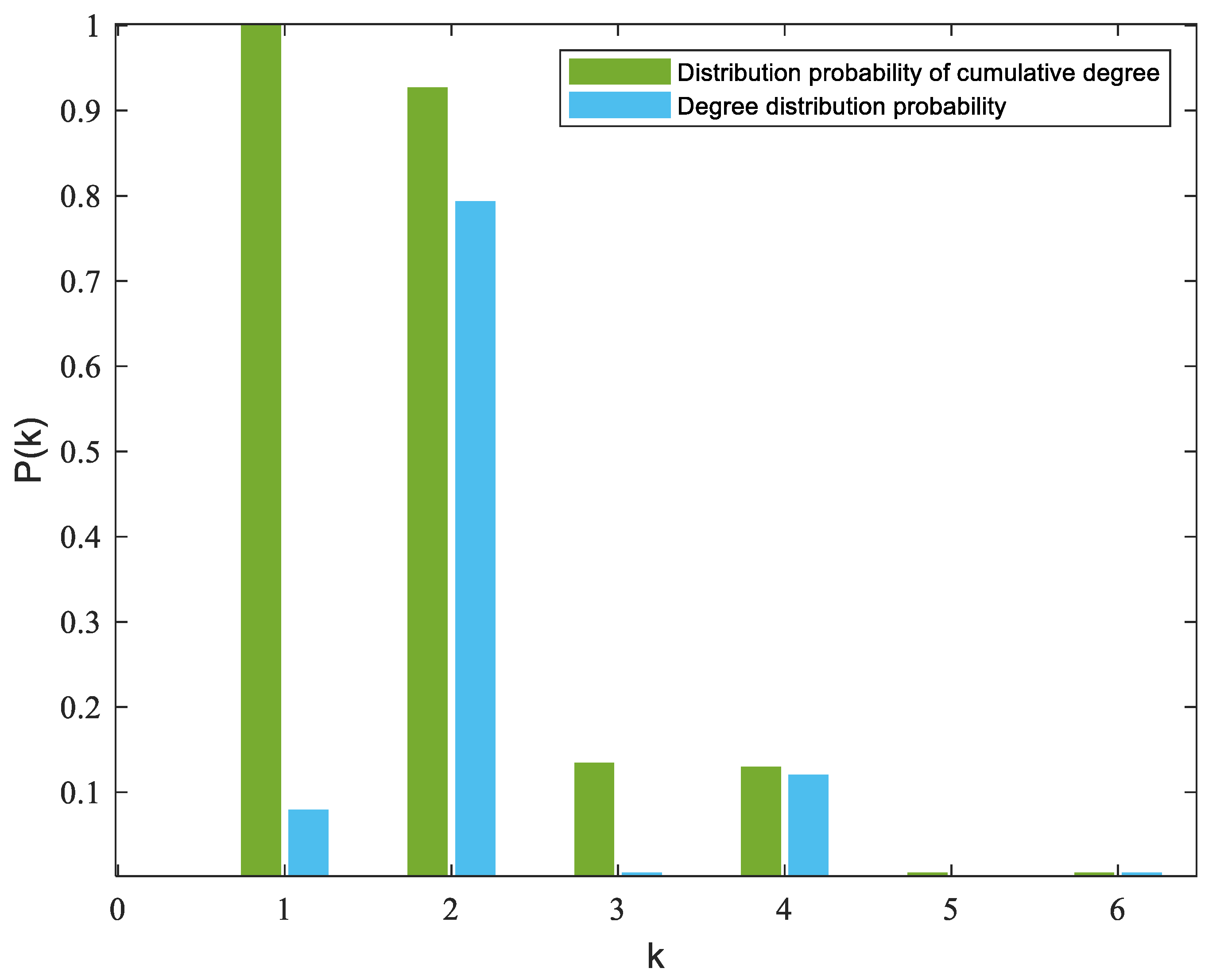
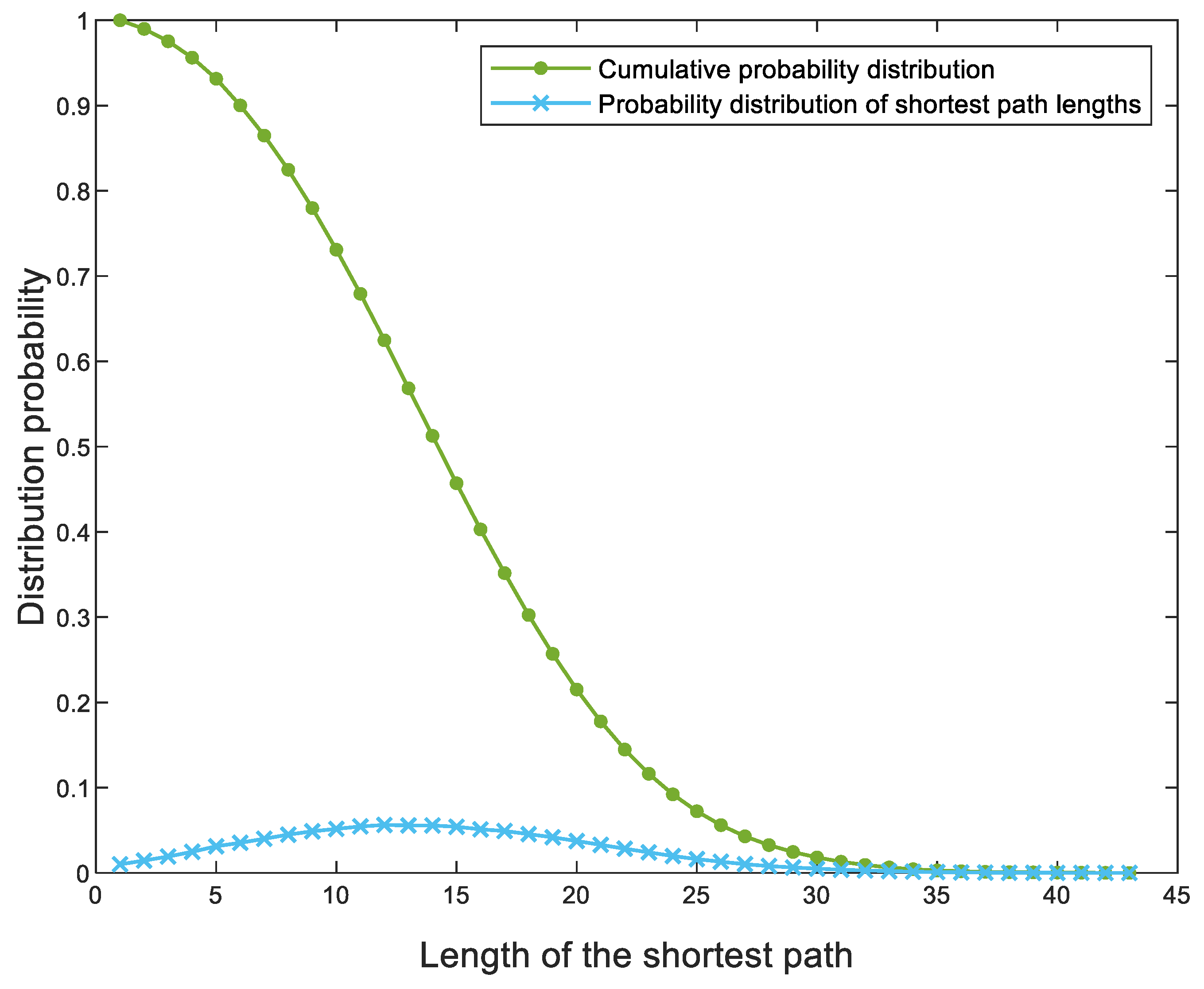
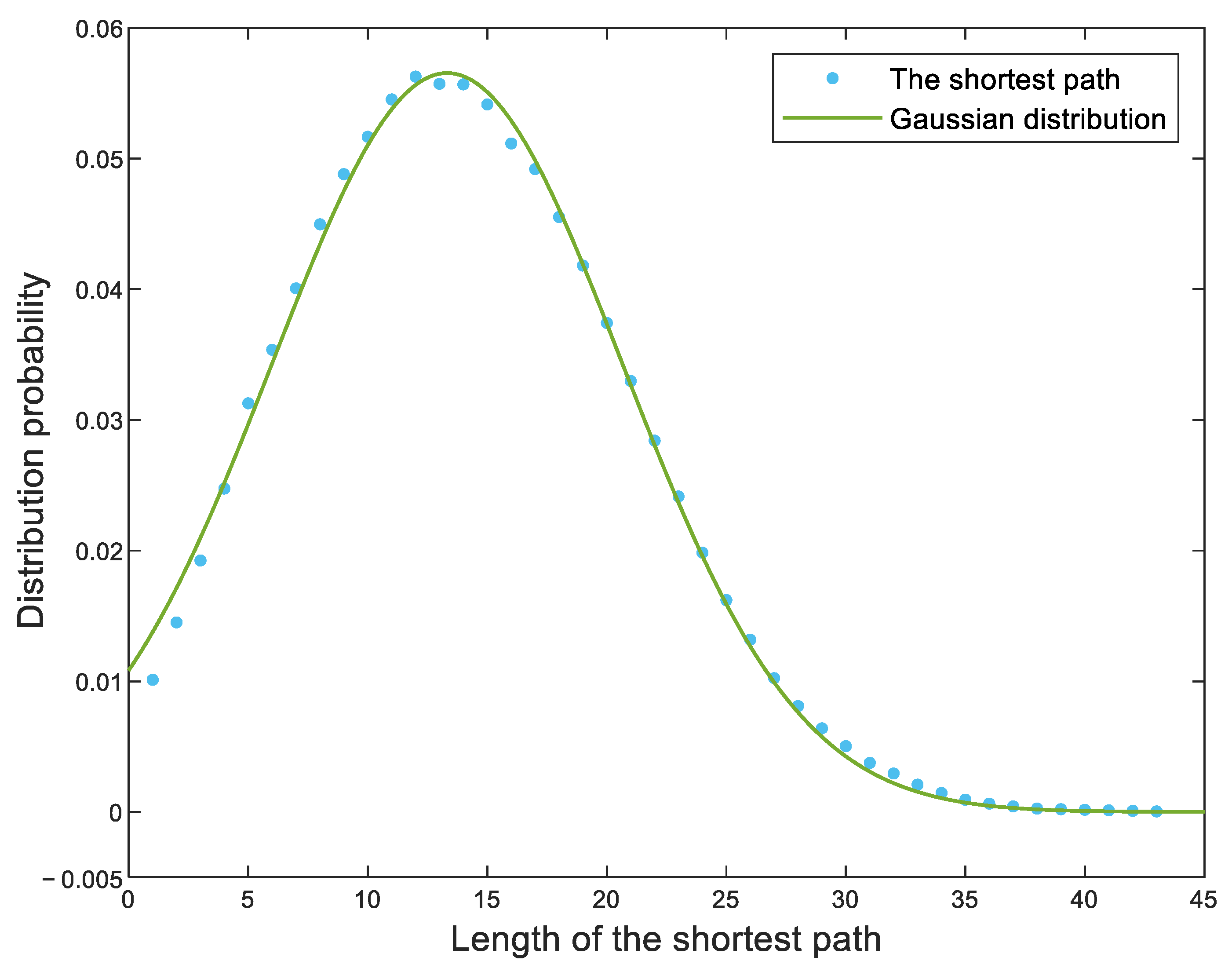

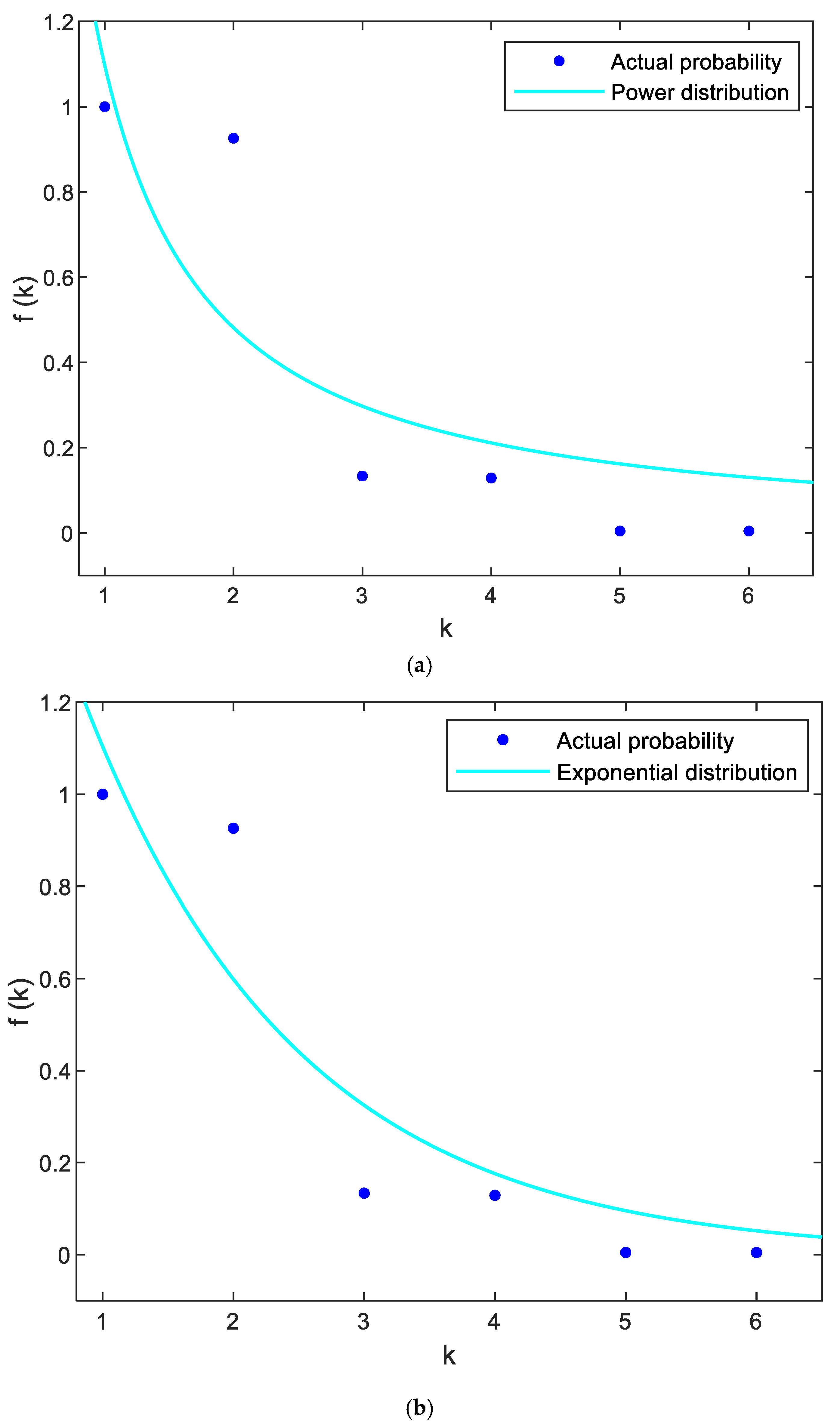


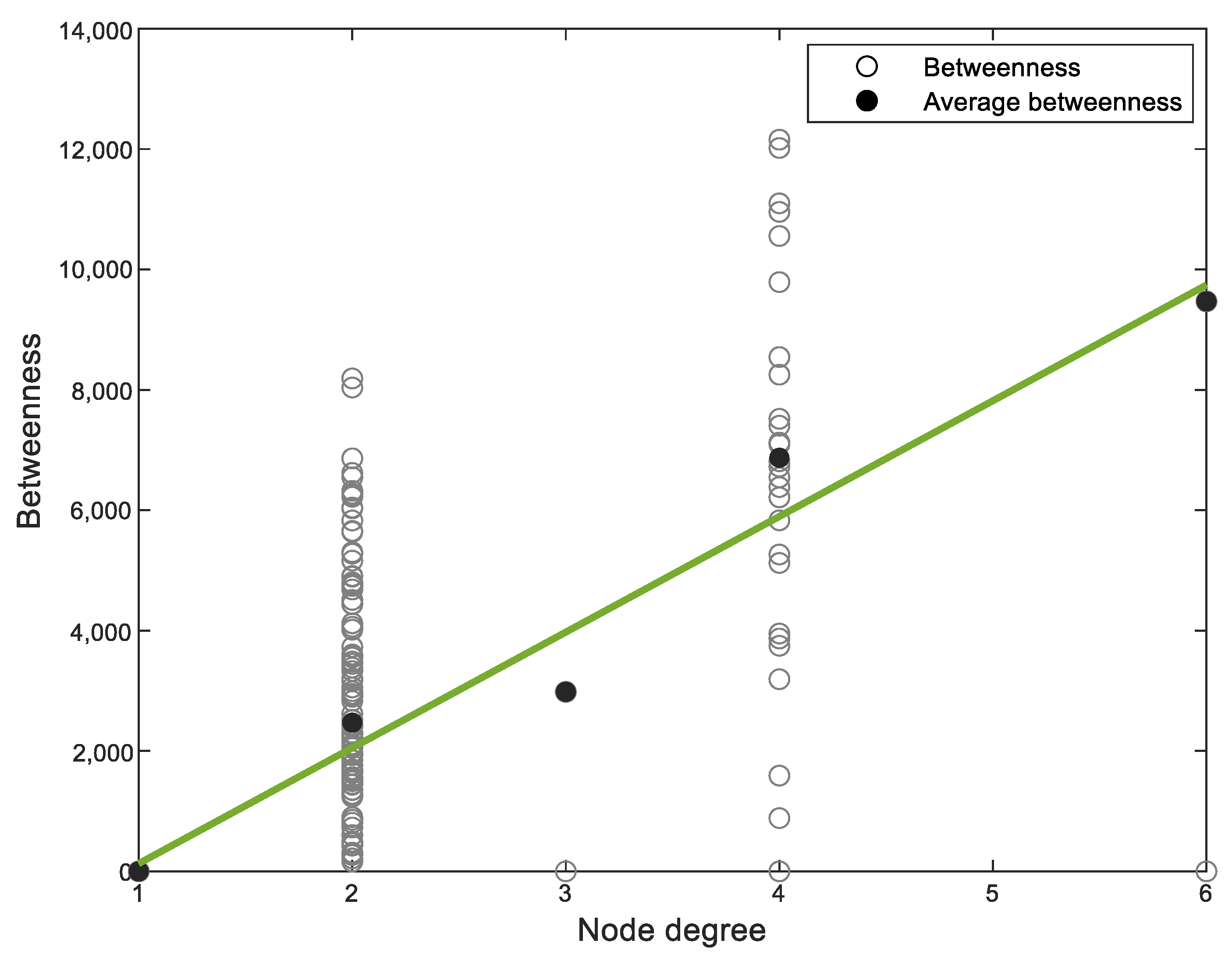



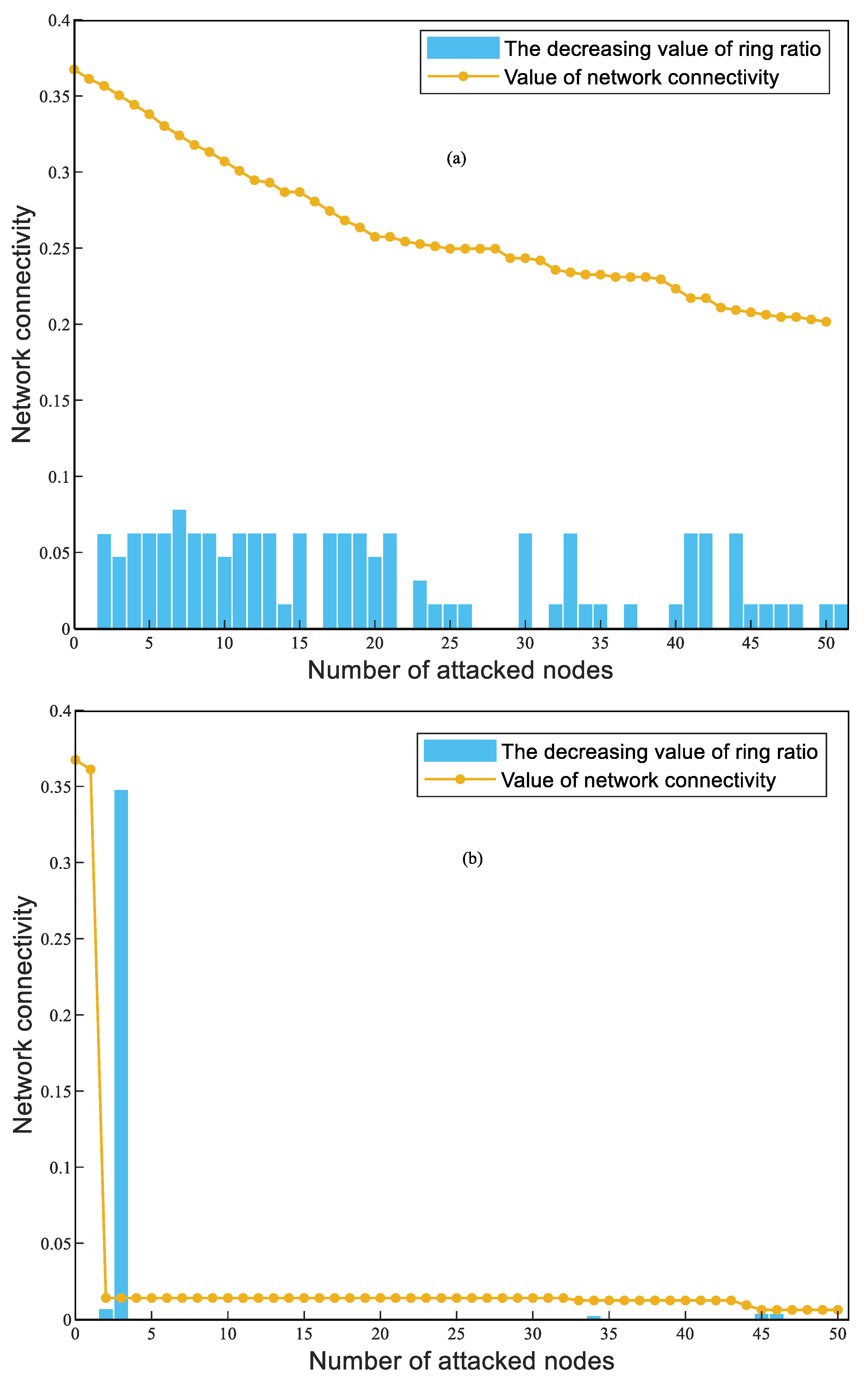

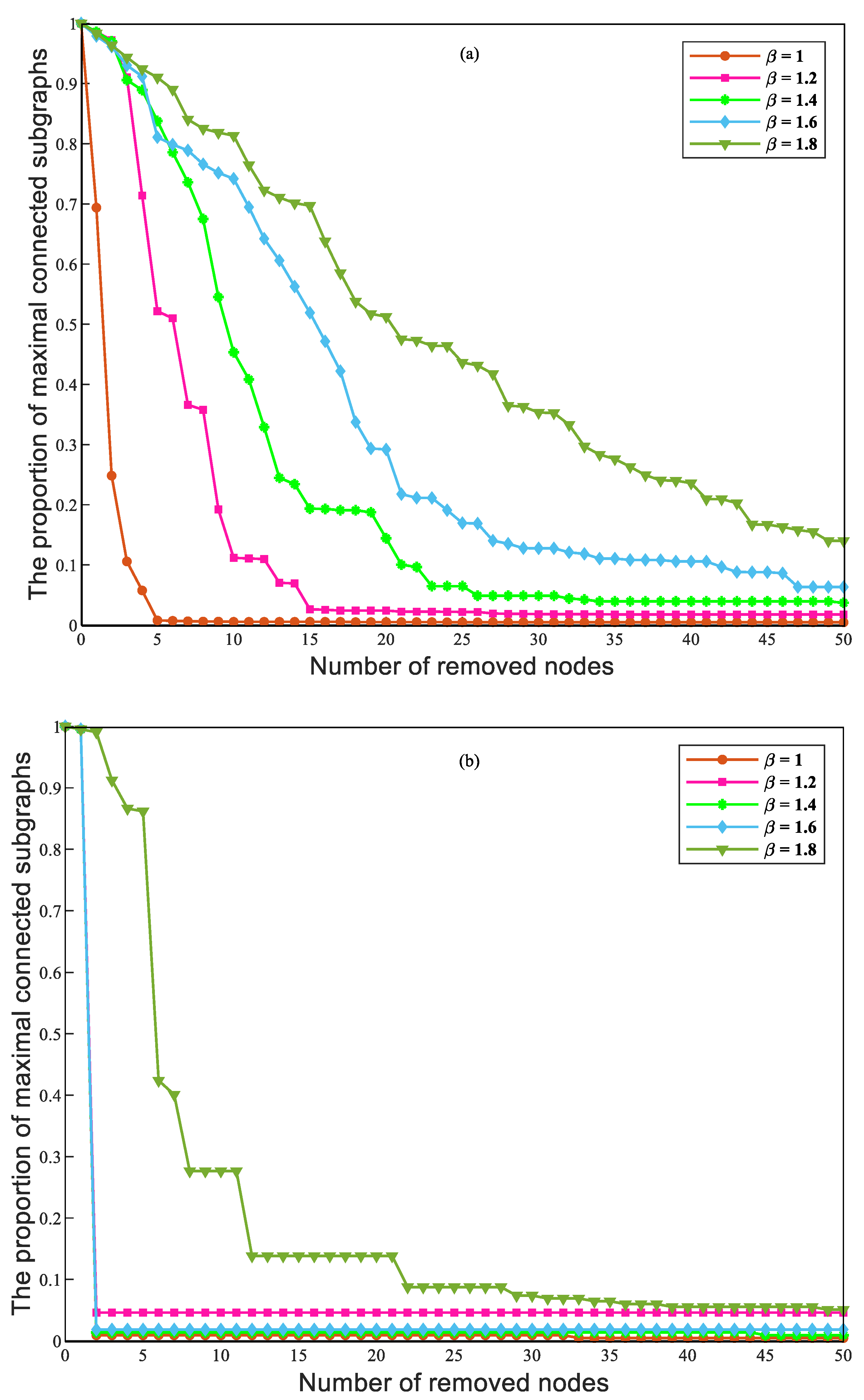
| Indicator | Value | Indicator | Value |
|---|---|---|---|
| Number of Nodes | 217 | Network Diameter | 43 |
| Number of network edges | 237 | Clustering coefficient | 0.0025 |
| Average Degree | 2.1843 | Maximum number of edges | 645 |
| Network Efficiency | 0.1056 | Connectedness | 0.3674 |
| Average Betweenness | 0.0306 | Average shortest path length | 14.1436 |
| Betweenness Interval | Distribution Probability | Betweenness Interval | Distribution Probability |
|---|---|---|---|
| 0.1–0.2 | 3.23% | 0.04–0.06 | 11.98% |
| 0.08–0.1 | 2.30% | 0.02–0.04 | 28.57% |
| 0.06–0.08 | 9.68% | 0–0.02 | 44.24% |
| Year | Number of Nodes | Number of Edges | Average Node Degree | Network Efficiency | Average Betweenness | Clustering Coefficient | Average Shortest Path Length | Connectivity |
|---|---|---|---|---|---|---|---|---|
| 2016 | 23 | 22 | 1.9130 | 0.2486 | 0.1667 | 0 | 8 | 0.3493 |
| 2017 | 46 | 45 | 1.9565 | 0.1677 | 0.1233 | 0 | 11.8493 | 0.3409 |
| 2019 | 77 | 77 | 2 | 0.1329 | 0.0829 | 0 | 13.4282 | 0.3422 |
| 2020 | 95 | 96 | 2.0211 | 0.1204 | 0.0743 | 0 | 14.8172 | 0.3441 |
| 2021 | 122 | 127 | 2.0820 | 0.1214 | 0.0429 | 0.0036 | 11.2208 | 0.3528 |
| 2022 | 136 | 143 | 2.1029 | 0.1220 | 0.0433 | 0 | 12.5995 | 0.3557 |
| 2023 | 155 | 160 | 2.0645 | 0.1060 | 0.0462 | 0 | 15.1479 | 0.3486 |
| 2024 | 182 | 192 | 2.1099 | 0.1018 | 0.0399 | 0.0024 | 15.3742 | 0.3556 |
| 2025 | 217 | 237 | 2.1843 | 0.1056 | 0.0306 | 0.0025 | 14.1436 | 0.3674 |
| Indicators | Clustering Coefficient | Average Shortest Path Length |
|---|---|---|
| Hefei Subway Network | 0.0025 | 14.1436 |
| Random Network | 0.0069 | 5.9350 |
| Shanghai Subway Network | 0.3667 | 15.2208 |
| Shenzhen Subway Network | 0.3678 | 12.0769 |
| Station Number | Station Name | Clustering Coefficient |
|---|---|---|
| 14 | Hefei South Station | 0.0476 |
| 15 | South Square Station | 0.1000 |
| 143 | Shengda Station | 0.1000 |
| 150 | Yicheng Station | 0.1000 |
| 151 | Provincial Administrative Center East Station | 0.1000 |
| 188 | Huifu Road Station | 0.1000 |
| Station Name | Node Degree | Closeness | Average Closeness |
|---|---|---|---|
| Hefei South Station | 6 | 0.0667 | 0.0667 |
| South Square Station | 4 | 0.1667 | 0.0321 |
| Shengda Station | 4 | 0.1667 | |
| Yicheng Station | 4 | 0.1667 | |
| Provincial Administrative Center East Station | 4 | 0.1667 | |
| Huifu Road Station | 4 | 0.1667 |
Disclaimer/Publisher’s Note: The statements, opinions and data contained in all publications are solely those of the individual author(s) and contributor(s) and not of MDPI and/or the editor(s). MDPI and/or the editor(s) disclaim responsibility for any injury to people or property resulting from any ideas, methods, instructions or products referred to in the content. |
© 2022 by the authors. Licensee MDPI, Basel, Switzerland. This article is an open access article distributed under the terms and conditions of the Creative Commons Attribution (CC BY) license (https://creativecommons.org/licenses/by/4.0/).
Share and Cite
Yin, X.; Wu, J. Simulation Study on Topology Characteristics and Cascading Failure of Hefei Subway Network. Sustainability 2023, 15, 422. https://doi.org/10.3390/su15010422
Yin X, Wu J. Simulation Study on Topology Characteristics and Cascading Failure of Hefei Subway Network. Sustainability. 2023; 15(1):422. https://doi.org/10.3390/su15010422
Chicago/Turabian StyleYin, Xiaohong, and Jiakun Wu. 2023. "Simulation Study on Topology Characteristics and Cascading Failure of Hefei Subway Network" Sustainability 15, no. 1: 422. https://doi.org/10.3390/su15010422
APA StyleYin, X., & Wu, J. (2023). Simulation Study on Topology Characteristics and Cascading Failure of Hefei Subway Network. Sustainability, 15(1), 422. https://doi.org/10.3390/su15010422







